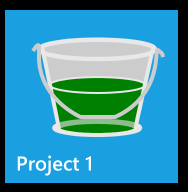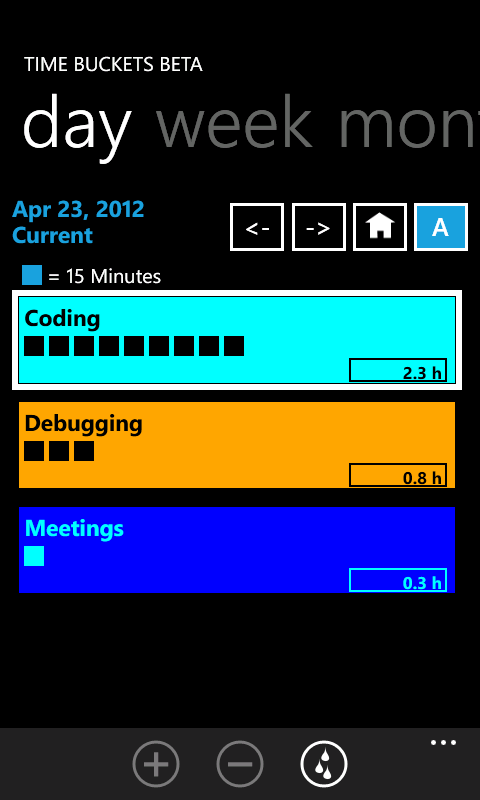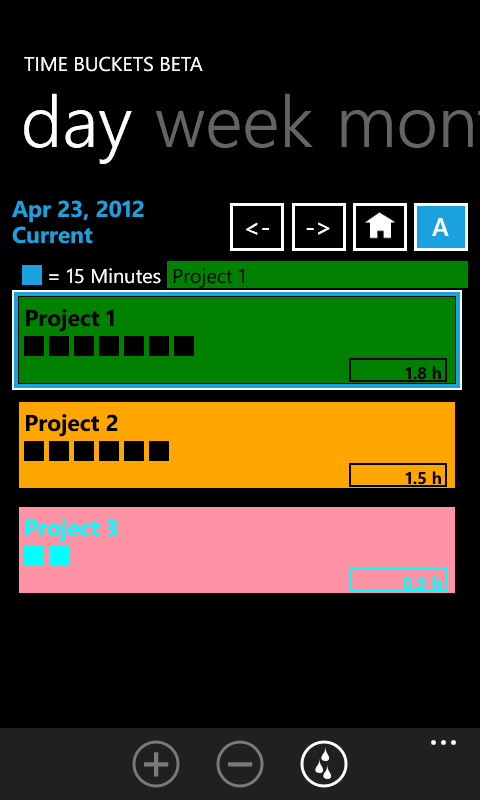| Services | We Are: | Kate (blog) Brian | Contact Us |
|
 |
Time BucketsGregory Consulting is pleased to announce the release of Time Buckets for Windows Phone 7 or 8, our time tracking application. Time Buckets provides a natural and simple way to track the time you spend - project by project, activity by activity, whatever way you want to track it. You create one or more "buckets" and then let time flow into the buckets - the app doesn't need to have focus while time is being recorded, in fact your phone doesn't even need to be on. You can look and see how you're spending your time over a day, week, month, or year at a glance. |
 Here, no bucket is active. Click the falling drops button on the AppBar to set an active bucket. This user has named the buckets as actions. |
 Here, the Project 1 bucket is active (accent border around it and stripe under the navigation buttons.) This user has named the buckets as projects or clients |
Made a mistake? No problem. You can toss an extra 15 minutes into a bucket with a single tap, or take 15 minutes out. You can "go back in time" to turn off time flow into a bucket, or to switch it to a different bucket. And you can edit any bucket, any time. Your data is backed up on request to your SkyDrive, and you can export a CSV if you'd like to do some analysis. After all, tracking your time shouldn't be complicated, timeconsuming, or something you don't dare forget. Time Buckets is simple, supportive, and adaptable.
When you install Time Buckets, the first thing you'll want to do is add a bucket to capture time in. Click the ... to bring up the Menu and choose New Bucket. You can name your buckets whatever you want and use whatever kind of colour scheme you want. Some people make the background colours meaningful (green for billable work, blue for personal, that sort of thing) while others want a different background colour for every bucket so the live tile will remind them what they're collecting time into. Once you have one bucket, when you add another you will see the ones you already have. Not only will that help you keep things distinct or the same, you can click a bucket to reuse the colours for your new one.
Once you have Time Buckets installed, consider pinning it to your start screen. The live tile shows an empty bucket when you're not accumulating time. When you are sending time to a bucket, the live tile draws the bucket half full of the background colour for that bucket, and includes the bucket name underneath that.
There are 6 views: hour, day, week, month, year, and all. On each view you can use the navigation bar to move forward and backward with the arrows. The Home button takes you to the current date and time. The Auto button next to it navigates you automatically. When it's active, if you're on the hour view at 10:59 you'll be seeing the hour that spans 10:00 to 11:00, and when you glance back a few minutes later you'll be seeing the hour that spans 11:00 to 12:00. If you don't like that, turn Auto off and you'll stick on a selected time span until you navigate to a later one, no matter how much time passes.
Realize that yesterday's totals are a complete mess? Navigate to the hour that includes the wrong part, select a bucket that has too much time, and on the Menu choose Transfer Bucket. Type in how much time to take from it, and select what bucket to send it to. Or choose Edit Bucket and just change the time that accumulated in that bucket during that hour. (You can only make changes to the time that accumulated when you're on the hour view. The other views are for seeing how your time was spent.)
The Transfer function is also useful when a project ends. If you don't want to track that time separately any more, you can transfer it all to some sort of archive bucket.
You can also bring up the Menu and choose Settings to bring back a hidden view (just uncheck it from the Hidden Views list) and to govern whether empty buckets should be shown and how buckets are considered "old" and not shown.
You can keep copies of your time on SkyDrive. Bring up the Menu and choose SkyDrive. Since Skydrive only supports a few file types, we save .txt files, but inside them we use two different formats. Export writes a comma separated values (csv) file - after you rename it from .txt to .csv you can open it with Excel and make graphs, track trends and totals, and manipulate your data however you want. Backup writes a file of XML. You can restore from an XML file any time. You might want to adopt a naming convention like May5bak.txt or May7csv.txt to help you tell these apart when you're restoring. Or you could keep them in different folders on your SkyDrive.
After you choose SkyDrive on the Menu, click the link to Backup, Restore, or Export. The first time, you'll need to sign in to your SkyDrive account and consent to the application accessing it.
When you're doing a backup, don't press Back or the Windows key until you see the message that your backup is complete. It won't continue if you leave the page. (If you want to check that your backup is good, just open it in notepad. If it ends </BucketsBackup> then you have a complete file.)
Once you direct the falling drops into a particular bucket, you don't need to keep the app open, or even keep your phone on. We just record that at this time, you started on Project 1 or whatever your bucket is called. Eventually you will send the drops to a different bucket or turn them off, and then we'll subtract to work out how long you spent working on Project 1. As a result there are two times you should NOT be sending the drops to an active bucket: